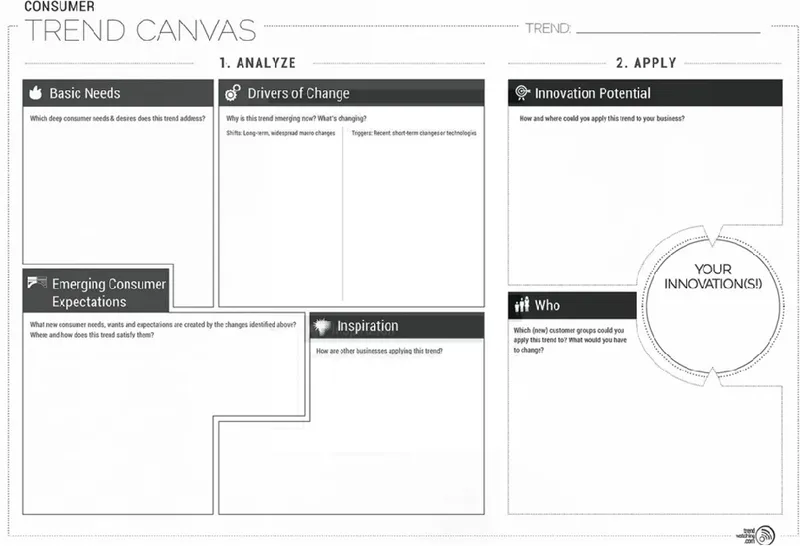The Consumer Trend Canvas: innovation tips to succeed in the Expectation Economy
In a hyper-connected hyper-competitive world, technology transformations are driving new business models and consumer behaviour changes. A range of free tools are now available for aspiring innovators, such as the Business Model Canvas, Value Proposition Canvas, and Storytelling Canvas. A new tool has now been added to this mix: the Consumer Trend Canvas, to identify changes in consumer expectation and behaviour.

“The Expectation Economy is built on the convergence of customer expectation: rising quality, positive impact, and personal expression,” begin the authors of the book ‘Trend-Driven Innovation: Beat Accelerating Customer Expectations.’
Henry Mason is Managing Director of TrendWatching.com, and the co-authors are his colleagues David Mattin (Global Head of Trends and Insights), Maxwell Luthy (Head of North American Business), and Delia Dumitrescu (Lead Innovation Architect).
The 14 chapters in the 352-page book are packed with charts, tables, mini case-studies, and sometimes too many conflicting colours. The material makes for a straightforward read, though it gets repetitive in some sections. The book has an online companion with activities and tools for innovators.
The Expectation Economy
Startups like Uber have raised customer expectations for prompt, interactive, and personalised service across domains. Customers also expect component transparency and to be able to experiment with different services before finalising their choice. They want ‘meaningful consumerism’ powered by peer ratings and co-creation.
Customers want products which have not just a reduced negative impact but a positive impact; they also want self-improvement, via physical, mental, emotional and spiritual betterment (e.g., with rewards for good behaviour). Startups are much better positioned than incumbents to launch such ‘clean slate brands.’ I have summarised some of these inter-connected strands in Table 1 below.
Table 1: The Expectation Economy
Trend components and types
To unpack and harness consumer trends, innovators need to understand the core elements of a trend: basic needs, change drivers, and innovations. Consumer needs are wide and diverse: security, relevance, identity, social status, self-improvement, entertainment, excitement, connection, social interaction, creativity, fairness, honesty, freedom, recognition, simplicity, and transparency.
The authors classify drivers of change into two types: shifts and triggers. Shifts are the long-term, macro changes that are playing out across years or even decades, such as ageing or climate change. Triggers are the more immediate changes, such as new technologies, political events, economic shocks, or environmental incidents.
Innovations are specific technologies or products, often launched by startups. Innovation lies in the brand’s product/service/experience, business model, marketing, and long-term vision (see also my book review of ‘Ten Types of Innovation’).
Truly successful innovators are customer-centric but not necessarily customer-led; they even create new trends while successfully riding other trends. It is not just consumer behaviour that yields trend insights, but also the activities of businesses such as startups and MNCs.
There are numerous sources of information about trends: media, spotter networks, crowdfunding sites, conferences, and even comedy; successful innovators can spot trends even in daily life activities around them. Spotting trends correctly does not necessarily guarantee business success, the authors caution, as seen in the demise of Webvan and MySpace.
Some interesting trends identified by the authors include the Internet of Caring Things, Fempowerment, Flawsome (businesses transparently admitting their flaws along with commitment to overcome them), Youniverse (customisation), and Celebration Nation or Local Love (revival of local cultures).
One chapter covers post-demographic trends, going beyond traditional classification into age, gender, and occupation. Social media allows users to create and join entirely new tribes of taste and interest, which can be interpreted via big data and analytics.
Trend adaptation
Once trends are identified, they need to be assessed for exploitation via three criteria: maturity, locality, and industry. Traditional bell curves of adoption patterns are being replaced by more sharp spikes (see my book review of ‘Big Bang Disruption’).
The consumer need for safety is being interpreted in different ways in countries across the world, for example, personal safety apps for women in India, food safety apps in China, fire-detection sensors in South African slums, and child abuse reporting sites in Brazil.
The authors classify the timeline of needed responses to trends into current, medium-term and future frames. The ‘consumer trend radar’ maps these onto the innovation categories of product, marketing, business model, and vision; the responses in turn can be in varying degrees of urgency, for example ‘red flag’ or light response. The end results can lead to small tactical shifts, or long-term strategic realignment.
Consumer Trend Canvas
The authors have developed a useful tool for tracking trends and mapping responsive ideas and innovations, called the Consumer Trend Canvas. ‘Emerging Consumer Expectations’ identifies expectation gaps in the market, and ‘Inspiration’ lists other companies who are already riding this trend. ‘Who’ breaks down the target audience segments, and ‘Innovation Potential’ or ‘Innovation Target’ specifies the scope of response in the four categories of innovation.

Use of this canvas is illustrated by the authors in mapping how the trend of ‘Sympathetic Pricing’ led to Uber giving discounts during Boston bus strikes, and ‘Self-improvement’ led to GOQii connecting fitness data to trainers and CodeMentor providing instant video help for coders.
Success of such brainstorming sessions depends on a good moderator or facilitator, a creative environment, and diverse methods of expression. Internal tools and external ecosystem partnerships for such trend-riding include KILN’s IdeaKeg, PHD Source, Vodafone-THNK, Telefonica Wayra, GE Garage, and Mondelez Fly Garage incubator.
In the longer run, organisations must build internal ‘trend muscles’ via regular trend-storming activities and a culture of curiosity (see my book review of ‘The Idea Hunter’).
“Standing still is not an option,” the authors conclude.







